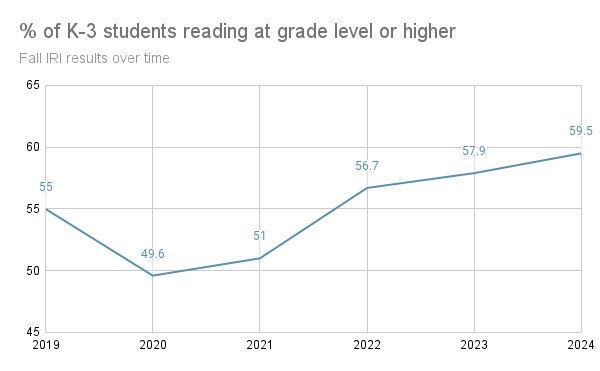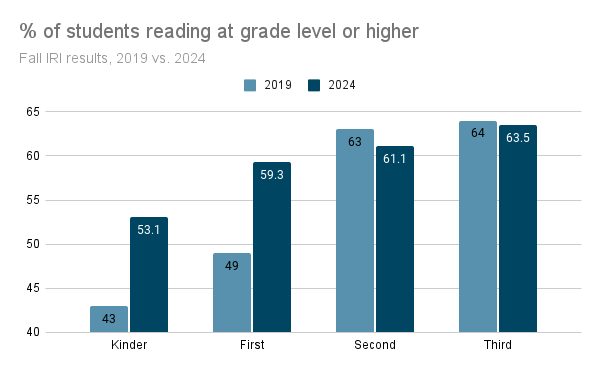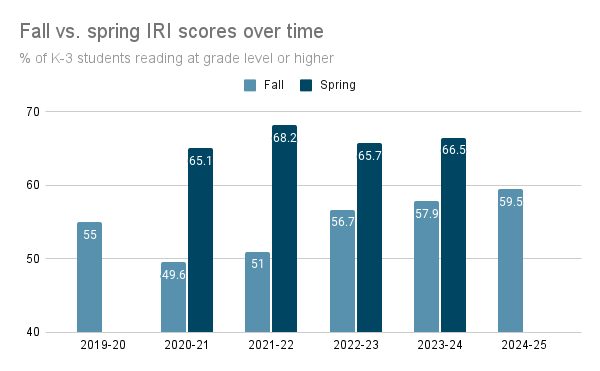Nearly 60% — or about 51,000 — of Idaho’s K-3 students are reading at grade level this fall, according to just-released results from a statewide reading exam.
That’s up from last fall, when about 58% of students were reading at grade level. Literacy rates have been steadily improving in Idaho since 2020, when less than half of students were on track with their reading.
First-, second- and third-grade reading scores also improved, but stagnated at the kindergarten level.
“The gains students are making in early literacy are steady and improving and our priorities around early literacy show our commitment as a state towards meeting reading goals by third grade,” state superintendent Debbie Critchfield said in a news release. “The work that districts and charters are doing with phonics and the science of reading will lead to continued progress for our students.”
About Idaho’s reading exam
- The exam, called the Idaho Reading Indicator, measures reading ability and progress.
- Idaho students in kindergarten through third grade take the IRI each spring and fall, as is required by Idaho code.
- The IRI helps educators better understand the needs of early learners in the areas of phonics, phonemic awareness, fluency, vocabulary and reading comprehension.
- Fall results are used to identify students who many need additional instruction and interventions to support their learning throughout the school year.
The progress comes amid multimillion-dollar investments in early literacy, a record number of schools offering full-day kindergarten, and more education leaders pushing to expand preschool access.
Still, there are nearly 35,000 K-3 students (or 40.5%) who are not reading at grade level. That figure includes about 8,500 third-graders (or more than 35%) who are behind.
Third-grade scores are especially worth paying attention to because according to Idaho statute, “it is the ultimate goal of the legislature that every student read at or above grade level by the end of grade 3.”
And while overall scores are besting pre-pandemic rates, second- and third-grade scores still haven’t caught up to 2019 literacy levels.
See how your school did
About 86,000 Idaho students took the IRI this fall. For a breakdown of scores by districts and charters, go here. For a breakdown of scores by schools, go here.
Five different ways to consider the fall reading scores, in charts
There are many ways to parse data, and each tells a different story. Here are five charts that provide perspective on the fall reading scores.
Tracking fall IRI results since 2019
Fall IRI scores have improved by nearly 10 percentage points since 2020.

Comparing pre-pandemic scores to 2024 scores
Kindergarten and first-grade scores have increased notably since fall 2019, but second- and third-grade scores still haven’t caught up with pre-pandemic literacy rates.

Comparing last fall’s results to this fall’s results
First-, second- and third-grade scores improved from last year’s, but kindergarten literacy rates remained stagnant.

Comparing fall and spring results over time
Idaho students’ reading abilities usually decline over the summer, but pick back up by the end of the school year. While fall literacy rates have shown steady improvement, spring literacy rates have been more sporadic.

Tracking a cohort: this year’s third graders
In this chart, we take a look at this year’s third-graders, and their scores on the fall IRI over time. Their progress has steadily shot up since kindergarten, improving by nearly 23 percentage points.

Idaho Education News data analyst Randy Schrader contributed to this report.
